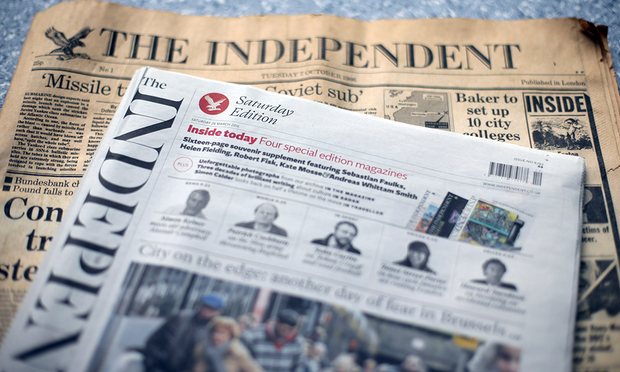The final print edition of the Independent was greeted with a fond farewell from journalists around the world as it hit the stands on Saturday, its last day before the title moves to a digital-only format.
The paper ends with an exclusive story about a British connection in a plot to kill a Saudi king, and a striking image of train passengers being evacuated during an anti-terrorism operation in Brussels, on its final front page. A special wraparound says simply “STOP PRESS”.
Referring to the demise of the paper in print as a “bold transition” in its final editorial, which it says “history will judge as an example for other newspapers around the world to follow”.
The paper was launched by a group of journalists led by Andreas Whittam Smith in 1986. It enjoyed initial success rising to a circulation passing 400,000 by 1988, and a Sunday title was launched in 1990 with Stephen Glover as editor. The last edition of the Independent on Sunday was printed last week.
It was announced in February that its owner, ESI Media, was closing the print editions. The company said it would create 25 new jobs at the online-only Independent, and a further 34 editorial roles would transfer to Johnston Press as part of the regional publisher’s acquisition of the i. More than 100 journalists across the two titles are facing redundancy.
Inside the paper, which was founded in 1986 under the slogan “It is. Are you?”, four special-edition magazines look back at its history including comments from foreign correspondent Patrick Cockburn, former journalist and Bridget Jones’s Diary author Helen Fielding and the paper’s former literary editor and Birdsong author Sebastian Faulks.
The final edition of the paper also features an investigation on vulnerable children who slip through the net when their families are re-housed and an interview with the former Labour communications chief Alastair Campbell by former editor Simon Kelner.
In a letter published in the final edition, publisher Evgeny Lebedev defended the Independent’s move online, saying journalism had “changed beyond recognition” and the newspaper “must change too”. He also extended his thanks to the paper’s “most important allies” – its readers.
“I know that today will be the last time you hear this newspaper crash through your letterbox; the last time you swap a smile and a few coins with the man in the corner shop and walk out with your daily bread under your arm,” the letter reads. “Some of you might have done that nearly 10,000 times since 1986. The depth of our gratitude is impossible to express.”
Its front page received praise from members of the industry including Jim Waterson of Buzzfeed UK, who said the paper “went out on a scoop”. Meanwhile, the BBC’s technology correspondent tweeted about the inclusion of a “wonderful collection” of photos from over the years. Jeremy Warner, associate editor of the Daily Telegraph, tweeted a picture of the first edition and the last edition together, praising its 30 years of “brilliant journalism”.
Andrew Marr, who started on the paper as part of the political team and later became its editor, recalled “breaking every rule of Westminster life” and said the paper had seen “some of the best journalistic writing in Britain in the 20th century”. Another former member of staff, Declan Walsh, Cairo bureau chief of the New York Times, tweeted his “sad, fond farewell” to the paper that gave him his first break.
The Guardian’s editorial on the transition to digital-only reads: “… the Indy may be leading where others might follow. The world of news is being turned upside down and inside out by a digital revolution which seems to be picking up pace by the week. There, but for the grace of the digital gods, go all of us.”
On Friday, journalists for the daily paper posted photos of their final hours working on the print edition and showed editor Amol Rajan giving a speech to a crowded newsroom after it was sent to press for the last time. They then all “banged themselves out”. Banging out is a long-standing British newspaper tradition in which journalists show their respect for departing colleagues.
Earlier Rajan tweeted a preview of two readers’ letters that feature in the last edition. One, signed by Guy and Caroline Carmichael from London, told how the pair met and fell in love through the newspaper. It reads: “While you may disappear in paper form, one edition will live for ever in our hearts: 20 November 1993. We found each other through your original Independent Hearts column, and were married in 1995. Thank you.”
The second, from J Samuel of Reading, said: “It is difficult to understand how the Independent, which took such a principled stand against Britain’s illegal invasion of Iraq, will be out of print before the inquiry into that invasion goes into print.”
The final editorial concludes: “Today the presses have stopped, the ink is dry and the paper will soon crinkle no more. But as one chapter closes, another opens, and the spirit of the Independent will flourish still.
“Our work goes on, our mission endures, the war still rages, and the dream of our founders shall never die.”
Meanwhile, Rajan’s final editor’s letter ends with the assertion that the move to digital-only “will be vindicated by history”. The final line reads: “The bird next to the masthead is taking flight again, and countless others will follow where this eagle dared.”










